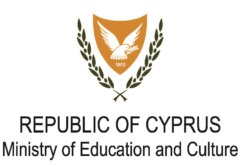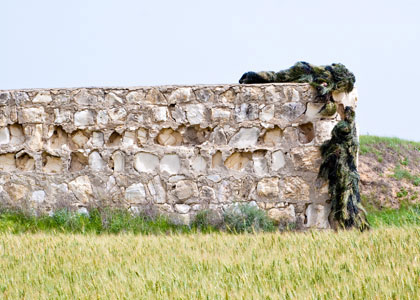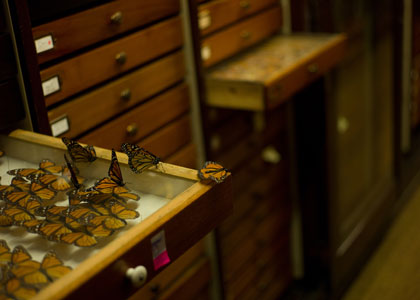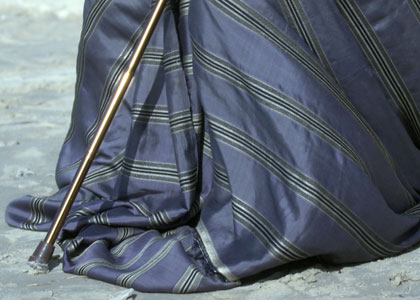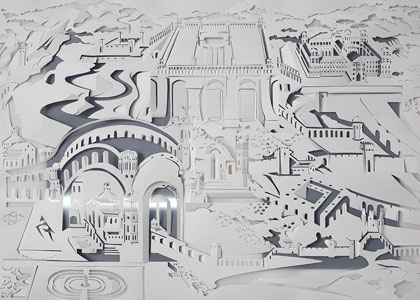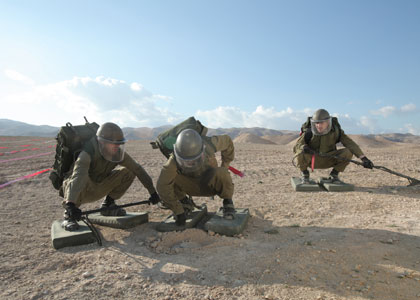

A Group Exhibition of Israeli Artists in Cyprus Curator: Drorit Gur Arie
“Periods of happiness are empty pages in history, for they are the periods of harmony, times when the antithesis is missing,” alerts Hegel (in The Philosophy of History). But how many such empty pages do we know? It seems as though, current history, certainly local history, is being written daily, hourly, in a triumphant constitution of capitalist production which, like a ventriloquist’s puppet, dubs a mythical past into a spectacle for a blinded audience. The fatalist rift, emergency, and destruction are our routine, the eternal stasis of a deadlocked struggle. Maybe these are, rather, the days of redemption, a present experienced as the cast shadow of a bleeding eternal past; perhaps in the spirit of Karl Marx, who, in reading Hegel’s Philosophy of History, regards history as a recurring sequence of tragic events which reconstruct themselves in a spiral movement, “once as tragedy, and again as farce” (The Eighteenth Brumaire of Louis Bonaparte). For Marx, the course of history can only be grasped in retrospect, as in a dream. Hence, the meaning of events and human actions experienced as the outcome of free will is a part of a hidden master plan. Even if a secular man is perceived as the writer of the play in which he himself performs, this does not negate his being a marionette in the service of another, religious spirit. Such may also be the tangled knot of the secular political discourse in Israel, which is bound up with the messianic one. Thus, under the vigilant eye of “the owl of Minerva,” man sets the wheels of “the eternal return of the new” in motion with unconscious gaiety.
About the Exhibition
The show brings together works by some of the most intriguing personal voices in Israeli video-art today. Their work reveals an affinity with the realms of ritual, Jewish symbolism, and cosmological cyclicality of life and death.
The participants represent a generation of young Israeli video-artists whose members have devised a variety of strategies for approaching the harsh, polarized reality surrounding them. All videos respond to one stratum or more in the multi-layered structure of identity, be it their individual, public, cultural, historic, or political one. Some, like Yael Bartana, Nevet Yitzhak, Amir Yatziv and Jonathan Doweck, appropriate forms, symbols, objects, and sites directly from the physical landscape, often to twist them into subtle political commentary. Others, like Shahar Marcus, employ humor as a tool for deconstructing history’s explosive potential, while yet others, such as Ran Slavin, mix sci-fi aesthetics and archaeological fantasy to portray the peculiar way in which these elements affect everyday politics in Israel. The personal poetry of Dafna Shalom, Dana Levy, Itzik Badash, and Yosef-Joseph Dadoune, exemplifies the work of mourning performed by many Israeli artists, in an attempt to come to terms with the violence of history, the violence of social hardship, or simply—interpersonal violence so prevalent in our region.
Reconstruction and repetition, a cyclic human state of struggle, construction and destruction, a fusion of reality, speculation, and fiction anchored in the fascinating relationship between ritual, place, and history—all these are at the core of “Recurrence.” Viewed together, the works present a spectacular, stylized, and eye-pleasing manifestation of violence. Eros and Thanatos are thus bound together in a Gordian knot.
The exhibition is the first project of Israeli art in Nicosia, Cyprus, staged in collaboration with NIMAC, Nicosia Municipal Arts Center.
Amir Yatziv & Jonathan Doweck, Paleosol 80 South, 2013, single-channel thermal video, 17:40 min, Courtesy of the artists
Yatziv: Born in Karmiel, Israel, 1972; lives and works in Ghent and Berlin
Doweck: Born in Israel, 1981; lives and works in Israel
Amir Yatziv and Jonathan Doweck’s video traces the surface of Har Karkom, a place identified by archaeologist Emmanuel Anati as the true site of the biblical Mount Sinai. The area, which in recent years was appropriated by the IDF and turned into an immense firing range, is populated by various training facilities reminiscent of monumental Minimalist sculptures. The video fuses the two powerful myths—the biblical and the military—into one, by juxtaposing images of Har Karkom shot through a thermal camera, with Anati’s diary entries heard in voiceover.
The result is a temporal mix-up. Are these huge concrete walls edifices of a silent, Brutalist, military architecture, a futurist monument, or the archaeological remains of an ancient cult? Two Bedouin metal scavengers perform nightly expeditions in the closed-off zone, searching for treasure to be sold on the black market. They act as mediators between the different narratives that inhabit this ancient, yet utterly futuristic, site.
Dafna Shalom , Fearful Days, 2006, video, 2:51 min, Courtesy of the artist
Born in Tel Aviv, 1966; lives and works in Tel Aviv
Dafna Shalom’s video trilogy, Fearful Days (2006-2010) brings religious and secular practices together, tradition and modernity, spiritual yearning and military aggression, ancient past and post-apocalyptic future.
The title alludes to a ten-day period during the Jewish month of atonement, Tishrei, beginning with New Year’s Day (Rosh Hashana) and ending at Yom Kippur, the Day of Atonement. It is a time when both the individual and the community are engaged in soul-searching and preparation for the holiest day. This spiritual and moral quest is symbolized by Shalom’s use of Jewish liturgy of Arabic origins in the work’s soundtrack. This spiritual background is contrasted with a stylized violent ritual.
In the trilogy’s third and final part shown here, two masked male figures are engaged in hand-to-hand combat, like ancient gladiators adorned with modern-day camouflage body-paint. The action is set against the backdrop of a field of green barley dotted with ancient ruins and stone walls. The dance-like battle is carried out in a ritualistic manner, and seems to represent a basic, existential man-beast struggle for survival. The work was created in the aftermath of the controversial Second Lebanon War (2006). As Shalom’s mysterious warriors gear up for battle, the ancient Jewish liturgy looms over their solemn faces: “Let us fall into the hands of the Lord, for his mercy surpasses all…”. Shalom’s lament, it would seem, stems from the very cyclicality of nature, life, and death latent in her works.
Dana Levy , The Wake, 2011, single-channel video, 5:03 min , Courtesy of Petach Tikva Museum of Art
Born in Tel Aviv; lives and works in New York and Tel Aviv
Dana Levy examines the museum via its various aspects as a cultural filter through which nature is perceived. She focuses on museum collections and the way they influence the production of institutionalized knowledge. The Wake was shot in the Mollusk Department at the Carnegie Museum of Natural History, Pittsburgh, where hundreds of butterfly species are kept in old cabinets, pinned and cataloged in exemplary order. The artist set 100 butterflies free, momentarily breathing life into an otherwise still and stifling space. This act of emancipation and flight reinforces the double meaning embedded in the work’s title, which signifies both the action of awakening and life, and a vigil held to commemorate the dead. The butterfly’s short lifespan is an emblem of freedom and liberation. At the same time, it is also a reminder of how impossible it is for beauty to exist under the suffocating, omniscient gaze of analytic knowledge.
Eyal Assulin , Fordizm, 2014, single-channel video, 5:07 min, Courtesy of the artist
Born in Ofakim, Israel, 1981; lives and works in Ofakim
Fordism, a term designating assembly-line industry, stands for modernity’s efficient, mass-produced, and standardized post-human culture, where man functions as an anonymous organ in an enormous socio-economic “machine.” Eyal Assulin’s video brings together man and machine for a pathetic, if not humorous confrontation. The artist, crouching on all fours, faces a Dodge Ram pick-up truck, as the two growl at each other like a pair of animals. Assulin’s repetitious single action performance is set to real time: it goes on until he loses his voice and is forced to quit. It is a hopeless battle against an indifferent machine, a vehicle which is also a status symbol. In a way, the artist is fighting the present-day bourgeois urban class, whose members buy these portable fortresses not due to occupational necessity (as a work tool), but as a means for social self-labeling. The video is shot against the backdrop of a dilapidated industrial space, which reinforces the work’s witty social commentary.
Itzik Badash , Zala, 2010, video, 13 min, Courtesy of Petach Tikva Museum of Art
Born in Netanya, Israel, 1977; lives and works in Israel
Female-sung eulogies are customary among Jewish congregations originating from Islamic countries. This is the core of Itzik Badash’s video work, Zala. “Zala” is the Arab-Libyan designation for the professional wailer, the female medium whose role is to arouse human emotions with her poetry and voice. Firmly rooted in the sands by the sea and wrapped in an oriental robe, the figure of the head wailer alternates between physical existence and spiritual trance. Her band of wailers perform their traditional craft while banging on old boards and pieces of furniture, as a slender youth robed in black satin steps into the sea.
Using this surreal syntax and imagery, Badash laments a dying tradition which belongs to a Jewish world cut off from its origins and customs through immigration and exile. Combining autobiographical, cultural, and historical elements associated with the tradition of Libyan Jewry, the video revives old rites of life and death. The backdrop for this piece is both autobiographical and collective, pointing to the history of Libya’s Jews who perished in Nazi concentration camps. This North African Holocaust had little or no recognition in official narratives of the Holocaust, hence the political significance of this video. By lamenting his own biography, the artist revives it: life and death are woven together, inseparably.
Nevet Itzhak , Where the Wild Things Are, 2014, video, 8 min, Courtesy of the artist
Born in Jerusalem, 1975; lives and works in Tel Aviv
Named after Maurice Sendak’s renowned children’s book, Where the Wild Things Are, Nevet Yitzhak’s work combines a childish fantasy with images of violence and horror. She uses Afghan war rugs as her point of departure. The Soviet invasion of Afghanistan in the late-1970s and a decade of occupation gave rise to new genres in rug design in the war-torn country. Some of the new war rugs are narrative in essence. They offer figurative depictions of modern weapons, portraits of soldiers and casualties, geographical maps, and the military struggles in each region. Today, however, what began as authentic expression of the changing reality and landscape of Afghanistan, has become a commodity for the tourist memorabilia industry.
Itzhak works with found video footage, reshaping her materials of choice to expose the politics of culture at play behind the scenes. She focuses on objects and visual patterns taken from the rich world of Islamic culture, both traditional and modern. Her works point to those twilight zones where cultures merge, and where notions of East and West are deconstructed. In Where the Wild Things Are, she takes up the Orientalist notion of the exotic far-off land, only to turn it into a tapestry of violence and war, complete with tanks and combat jets inspired by modern video games, as well as the violent reality around her.
Nira Pereg , Sarah, Sarah, single-channel HD video with sound, 4:25 min, loop , Abraham, Abraham, single-channel HD video with sound, 4:25 min, loop Courtesy of the artist and Braverman Gallery, Tel Aviv
Born in Tel Aviv, 1969; lives and works in Tel Aviv
Nira Pereg’s videos address border-lines, exploring the way in which metaphysical belief systems (religions and ideologies) manifest themselves in the physical reality in the form of concrete material barriers. The artist identifies and records those liminal spaces where human activity creates temporary division lines intended to separate the sacred from the profane, one religion from another, one public from another.
Both Sarah Sarah and Abraham Abraham were shot in the Cave of the Patriarchs in Hebron (Nablus) in the West Bank, one of the most sacred sites for both Jews and Muslims. The place is one in a series of “enclaves” controlled by the Israeli Defense Forces, inside a city which is essentially under Palestinian rule. Most of the cave’s area serves as a mosque, while the remaining section is used as a synagogue—a fragile status quo maintained under the watchful eyes of Israeli and Palestinian security forces.
For twenty days each year, during the time of various holidays, however, the cave exchanges hands for 24 hours, so that each group gains use of the entire compound for one day. In a matter of hours, the site is transformed from a mosque to a synagogue. The sacred paraphernalia become props in a religious cabaret “acted out” inside these ancient walls. Sarah Sarah and Abraham Abraham document this peculiar cycle that has been influencing religious cults and re-marking internal borders.
Peleg Dishon , Flood, 2012, video projection of a scanned paper-cut, Courtesy of Petach Tikva Museum of Art
Born in Kibbutz Shluhot, Israel, 1979; lives and works in Tel Aviv
The works of multimedia artist and self-proclaimed “techno-mystic” Peleg Dishon bring together the most ordinary manual craft work with the most advanced interactive and user-interface technologies. In Flood he creates an elaborate landscape made of black and white geometries, highly abstract yet strangely familiar. This made-up scenery is actually a hybrid of various images of the city of Jerusalem, taken from different sources as varied as Bruegel’s Tower of Babel, an ancient map of the celestial Jerusalem, popular postcards of the city printed in Israel, depictions of cities and castles by Albrecht Dürer, and the cover of the album Relayer by British band Yes. This seemingly deconstructivist picture is in fact an act of reconstruction, as the artist patches up the all-too-familiar image of the holy city from his childhood impressions and memories.
Is there a “real” Jerusalem? Would it not be true to say that any place—particularity a city that has been the center of fierce conflicts over religious and political domination—is many places rather than “one,” made of multiple realities, dreams, yearnings, and fantasies? Dishon’s mental picture of Jerusalem is a broken one, comprised of details that cannot be made into a unified whole, for the “eye” scanning them does so from an extreme close-up, allowing no “objective” perspective.
Ran Slavin , Ursulimum, 2012, video HD, color, 16:90 min, Courtesy of the artist
Born in Jerusalem, 1967; lives and works in Tel Aviv
Ran Slavin uses a mythical vision of Jerusalem as a stepping stone for his quest in time. Ursulimum is the first written reference to the Holy City in Egyptian records dating back to 1330 BCE. At the heart of today’s Old City of Jerusalem lies Har Habayit (Temple Mount), as it is known to Jews, or Al-Haram al-Quds a-Sharif (Noble Sanctuary), as it is known to Muslims, traditionally considered the place of the first two biblical temples and the site of Prophet Mohammad’s ascent to heaven. It is a politically explosive compound; the very mention of changing its status quo could wreak havoc on all of Jerusalem.
Slavin uses miniature backdrops and post-production effects to create a science fiction environment of tunnels and subterranean spaces supposedly located underneath the holy site. This maze is located both in the past and in the future: the boy-astronaut who travels through its secret shafts is an explorer of deep-space and a time-traveler. At the end of his path lies a mysterious magnetic field, a great shining light symbolizing ultimate truth and revelation. Slavin’s vision, however, is cut short before we get the chance to discover the mystery of Temple Mount. We are left with an empty set and no image to hold onto.
Shahar Marcus , Sabich, 2012, video, 4:33 min, Courtesy of the Israel Museum, Jerusalem and Braverman Gallery, Tel Aviv
Born in Petach Tikva, Israel, 1971; lives and works in Tel Aviv
Alluding to Action Painting and the art of Jackson Pollock, Shahar Marcus performs in front of the camera in his studio. A giant pita bread spread on the floor substitutes for the canvas, while the artist uses dripping amba and tahini sauces to replace Pollock’s dripping paint. Together with deep fried eggplant, boiled eggs and green salad, the ingredients come together to make a popular Israeli street dish of Iraqi origin called sabich. The sublime character of Abstract Expressionism is thus transformed into a vernacular, bodily, down-to-earth activity. Suffused with humor, this work undermines the myth of the artist’s self-importance, and absurdly blurs the distinctions between the creative process and an everyday Israeli experience. The final image is at once visceral, intended to stimulate one’s appetite, and “cosmological”—like a mandala unfolding a whole universe of tastes and scents.
Shahar Marcus , Seeds, 2012, video, 5:00 min, Courtesy of Braverman Gallery, Tel Aviv
Sigalit Landau, DeadSee, 2005, video, 11:39 min, loop, Courtesy of the artist
Born in Jerusalem, 1969; lives and works in Tel Aviv
In the past twenty years, internationally acclaimed artist Sigalit Landau has explored many geographical territories, both real and imaginary. She staged projects in a frozen lake in Gdansk, Poland, traveled aboard a concrete mixer in the Mannheim region of Germany, and transformed the Israeli Pavilion at the Venice Biennale into a throbbing sewage system. Despite her intercontinental reach, however, Landau keeps (re)turning to the Dead Sea for inspiration. Located at the lowest geographical point on earth, it is a salt lake fed by the waters of the Jordan River. The high consistency of salt in its waters prevents life from developing in it. All solid masses float on its surface, made as light as on the moon.
In DeadSee, the artist created a 250-meter long spiral of metal cable which pierces 500 watermelons, all afloat in the green waters. Alluding to Robert Smithson’s landmark work, Spiral Jetty (1970), Landau spins clockwise as she becomes a link in this giant DNA chain. Her naked body and outstretched arm reach for a point where several fruits have been sloshed open, bleeding their red meat into the green liquid surrounding them. The spiral gradually becomes a thin green line, eventually disappearing outside the frame. Although Landau presents a process of unwinding which results in disappearance, the video’s loop formation suggests an infinite recurrence, repetition with endless folding and unfolding of matter and information. The overall image suggests a gigantic eye, slowly spiraling toward oblivion and rebirth.
Yael Bartana , A Declaration, 2006, one-channel video and sound installation, 7:30 min, Courtesy of Annet Gelink Gallery, Amsterdam and Sommer Contemporary Art, Tel Aviv
Born in Kfar Yehezkel, Israel, 1970; lives and works in Amsterdam, Tel Aviv, and Berlin
Yael Bartana’s A Declaration takes place offshore along the invisible border between Tel Aviv and Jaffa. The video opens with the Israeli flag waving over Andromeda’s Rock, a spot which alludes to the Greek mythological princess sacrificed by her parents to save the kingdom, following her mother’s sin of hubris. A young man rows a boat carrying an olive tree, a highly charged symbol in both Israeli and Palestinian societies. He replaces the flag with the tree. The title of the work attests to the act itself, which is portrayed in a highly stylized visual manner, granting it its ritualistic impact. The work can be construed twofold: as a call to replace the Israeli national symbol with a “native” tree alluding to Palestinian national pride, to replace nationalism with the symbol of peace (the olive branch), or vice versa—as a declarative, symbolic act, reclaiming this watery no-man’s-land in the name of nationalism itself, again symbolized by the olive tree shared by both cultures.
Yosef-Joseph Dadoune , Ofakim (Horizons), 2009, video, 17:29 min, Courtesy of the artist
Born in Nice, France, 1975; lives and works in Tel Aviv
Yosef-Joseph Dadoune’s multimedia works blend autobiography with myth, the national and the universal, biblical symbolism and realist imagery drawn from his surroundings. Ofakim (Horizons), named after the artist’s hometown in the Negev desert, was created in collaboration with a group of local teenagers. The artist filmed a series of actions in and around Ofakim’s deserted textile factories. Group members stand in an upright “freeze” position, reminiscent of a Memorial Day service. These silent youths represent Ofakim’s multicultural, multi-ethnic social fabric. As they move out of the abandoned factory and into the desert, they carry a bomb-like object in a silent procession as if bearing a coffin, slowly disappearing over the horizon. Will they continue to embody their destiny as social outcasts, or will they manage to escape their own destinies in the “Promised Land” that has failed their parents?
Yosef-Joseph Dadoune , In the Desert, 2009, video, 15:03 min, Courtesy of Petach Tikva Museum of Art



